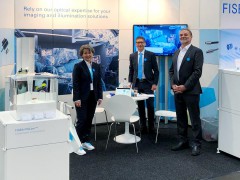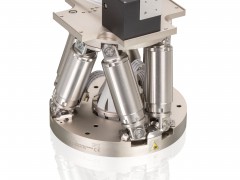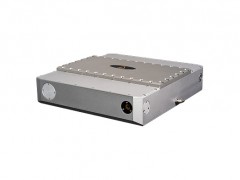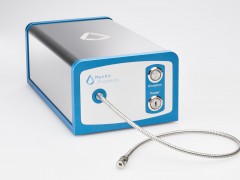
University of Michigan's HERCULES laser to be upgraded from 300 to 500 terawatts
source:Laser Focus World
release:Nick
keywords: lasers; HERCULES laser; laser technology
Time:2017-10-25

The HERCULES laser. (Photo: Joseph Xu, Michigan Engineering Communications and Marketing)
Aided by a grant of $2 million from the National Science Foundation, the 300 terawatt (TW) HERCULES laser at the Center for Ultrafast Optical Science (CUOS), part of the University of Michigan (Ann Arbor, MI), will be upgraded to produce 500 TW of peak output power -- with hopes of attaining 1000 TW, or 1 petawatt, of peak power.
The HERCULES laser currently holds the world record for the highest focused optical intensity, currently 20 sextillion (2x1022) W/cm2. The upcoming power upgrade may well help to break this record.
With the higher peak power, researchers at the University of Michigan and collaborators from around the world can make better tabletop devices that produce particle and x-ray beams for medical and national security applications, as well as explore phenomena in astrophysics and the quantum realm.
The power of the HERCULES laser comes from a series of five embedded pump lasers that amplify ultrashort pulses of light. To upgrade the peak power of HERCULES, the researchers will replace the final three of those pump lasers. If HERCULES can achieve 1000 TW, it would once again be among the most powerful lasers in the U.S.
A decade ago, when engineers at Michigan first built HERCULES, the commercial pump lasers the system relies on couldn't reach the ambitious 300 TW—record-breaking at the time—that the researchers had in mind. They had to build their own pump lasers. Now, driven by a demand from international projects seeking power levels upward of 10,000 TW, commercial pump lasers can outstrip the homemade versions that run in HERCULES today. This new technology is what will push HERCULES to higher power and intensity than ever before.
Some application areas:
Tabletop accelerators
Conventional particle accelerators are often hundreds of yards long, but laser light can power the acceleration of particles and produce other high-energy beams such as x-rays in just a few square yards or less. In the future, laser-driven particle accelerators may help reveal new physics or drive ultracompact x-ray lasers. Particle and x-ray beams can also be used to determine the presence of nuclear materials in shipping containers arriving at ports. They are used for medical treatments such as radiation therapy.
X-rays that differentiate among soft tissues
High-energy x-ray beams emitted by laser accelerators could enable advanced x-ray imaging that can find the boundaries between soft tissues, as opposed to conventional x-rays, which are best at picking out dense materials like bone. When the x-rays from a laser accelerator travel through different materials, their waves get out of sync to different degrees, and this can distinguish between a lung and a heart, for example. This method of measuring would be cheaper and offer faster results than an MRI.
Gamma ray bursts: astrophysical phenomena
How are flares of powerful electromagnetic radiation that last for no longer than a few seconds produced in space? One theory holds that very strong magnetic fields, near black holes for instance, may be breaking apart. When the magnetic field lines come back together they can accelerate particles that release these powerful bursts of electromagnetic energy in the form of gamma rays. By using the HERCULES laser in the lab, the team can create strong magnetic fields on microscopic scales that can break apart and reconnect in the same way, shedding light on whether this is really the mechanism behind gamma ray bursts.
Questions in strong-field quantum electrodynamics
Quantum electrodynamics—the quantum description of light and its interactions with matter—hasn't been adequately tested in some extreme situations. For example, when electric fields are strong enough, the phenomenon of "boiling the vacuum" is predicted occur: matter and antimatter can spontaneously appear from nothing. Electric fields this strong may be found in neutron star atmospheres, for example. The upgraded HERCULES laser can simulate these environments by accelerating electrons to near the speed of light, so that—from the vantage point of the electrons—the fields are strong enough to generate particles from the vacuum. By looking at how the electrons behave, researchers can deduce whether the predictions of quantum electrodynamics are accurate.
- RoboSense is to Produce the First Chinese Multi-beam LiDAR
- China is to Accelerate the Development of Laser Hardening Application
- Han’s Laser Buys Canadian Fiber Specialist CorActive
- SPI Lasers continues it expansion in China, appointing a dedicated Sales Director
- Laser Coating Removal Robot for Aircraft
 FISBA exhibits Customized Solutions for Minimally Invasive Medical Endoscopic Devices at COMPAMED in
FISBA exhibits Customized Solutions for Minimally Invasive Medical Endoscopic Devices at COMPAMED in New Active Alignment System for the Coupling of Photonic Structures to Fiber Arrays
New Active Alignment System for the Coupling of Photonic Structures to Fiber Arrays A new industrial compression module by Amplitude
A new industrial compression module by Amplitude Menhir Photonics Introduces the MENHIR-1550 The Industry's First Turnkey Femtosecond Laser of
Menhir Photonics Introduces the MENHIR-1550 The Industry's First Turnkey Femtosecond Laser of Shenzhen DNE Laser introduced new generation D-FAST cutting machine (12000 W)
more>>
Shenzhen DNE Laser introduced new generation D-FAST cutting machine (12000 W)
more>>
